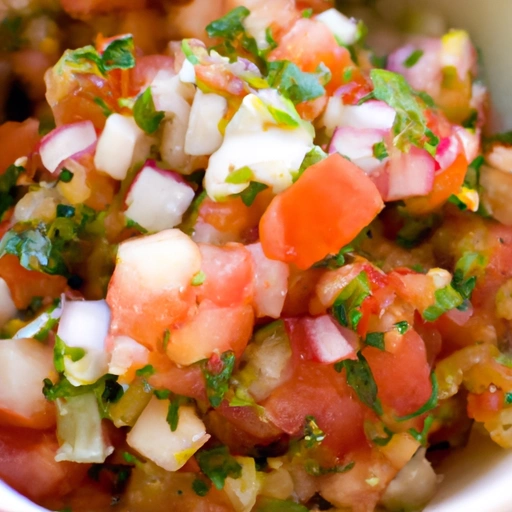Pico de Gallo
Description

Pico de Gallo, also known as salsa fresca, is a fresh, uncooked salsa commonly used in Mexican cuisine. It is made from chopped tomato, onion, cilantro, fresh serranos (jalapeños or other types of hot peppers may be used), salt, and lime juice. It’s a simple ingredient mix that provides a burst of freshness and a balance of flavors that can enhance a variety of dishes.
Common uses
Pico de Gallo is commonly used as a topping for tacos, grilled meats, and fish. It is a staple condiment in Mexican restaurants and households alike. Additionally, it serves as a flavorful addition to burritos, nachos, fajitas, and as a refreshing dip for tortilla chips. Its versatility spans beyond traditional Mexican dishes and can be incorporated into salads and sandwiches for a zesty twist.
Nutritional value
Calories
Typically, a serving of Pico de Gallo (about 1/2 cup or 120 ml) contains roughly 25 calories, depending on the specific quantities of the ingredients used.
Protein
Pico de Gallo is low in protein, offering less than 1 gram per serving.
Fat
This salsa is virtually fat-free, with total fat content being less than 0.5 grams per serving.
Carbohydrates
Carbohydrates are also minimal, with around 5-6 grams per serving, most of which come from the natural sugars found in tomatoes and onions.
Vitamins
Pico de Gallo is rich in vitamins, particularly Vitamin C from the tomatoes and lime juice, along with small amounts of Vitamins A and K from the cilantro.
Minerals
It contains a variety of minerals such as potassium and magnesium, and the onions provide a source of dietary fiber.
Health benefits
The ingredients in Pico de Gallo are known for their health benefits. Tomatoes offer lycopene, an antioxidant linked to reduced risk of heart disease and cancer. Cilantro may help in detoxifying heavy metals from the body, and the capsaicin in chili peppers has been shown to boost metabolism and aid in fat burning.
Potential risks
While Pico de Gallo is generally considered healthy, it may pose risks to individuals with certain allergies, such as those to tomatoes or cilantro. Additionally, the capsaicin in hot peppers can cause irritation to some people's digestive systems.
Common recipes
Pico de Gallo is often used in traditional Mexican recipes such as tacos al pastor, carne asada, and chilaquiles. It's also a common garnish for guacamole and can be used as a base for more complex salsas or marinades.
Cooking methods
As a raw salsa, Pico de Gallo does not require any cooking. Its preparation involves finely chopping and mixing the ingredients together, allowing them to marinate briefly to meld the flavors.
Pairing with other ingredients
Pico de Gallo pairs well with rich and creamy dishes, offering a fresh counterbalance to the palate. It complements avocado, cheese, and sour cream and can cut through the richness of fried foods.
Summary
Pico de Gallo is a fresh, vibrant, and versatile condiment that adds a splash of color and a burst of flavor to a plethora of dishes. It is a healthful addition that brings together the essential tastes of Mexican cuisine, with a harmony of tomatoes, onions, cilantro, and chili peppers, lightly seasoned with salt and lime juice. Whether used as a topping, a dip, or an ingredient, Pico de Gallo is a staple that transcends cultural boundaries, beloved for its simplicity and freshness.